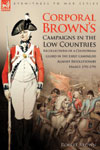|
CORPORAL BROWN’S CAMPAIGNS IN THE LOW COUNTRIES
by Robert Brown
|
 Where the hell is Lincelles? Subalterns may perhaps have hoped that the Brigade Major, during the Major General’s Inspection, would not ask them exactly where the First, Coldstream and Third Guards gained the first battle honour emblazoned on their Colours (after ‘the Sphinx superscribed ‘Egypt’’). Corporal Robert Brown of 1st Bn Coldstream Guards’ Grenadier Company supplies the answer in his ‘Recollections’ written in September 1795. Where the hell is Lincelles? Subalterns may perhaps have hoped that the Brigade Major, during the Major General’s Inspection, would not ask them exactly where the First, Coldstream and Third Guards gained the first battle honour emblazoned on their Colours (after ‘the Sphinx superscribed ‘Egypt’’). Corporal Robert Brown of 1st Bn Coldstream Guards’ Grenadier Company supplies the answer in his ‘Recollections’ written in September 1795.
s
France’s Revolutionary Convention declared war on Great Britain on 1st February 1793, ten days after King Louis XVI’s execution, although British treaty commitments guaranteeing the security of the Austrian Netherlands (today’s Western Belgium) and [Dutch] Netherlands formed the casus belli: Austria and Prussia had been fighting France for nine months. General Dumouriez’ operations to seize the Scheldt waterway for France prompted George III to order the seven British Footguards Battalions to parade and ‘hold themselves in readiness to embark for foreign service’. Inevitably, the British Army was not at that time manned, equipped, sustained, trained and at high readiness for an enduring large-scale deployment. Nevertheless, five days later, the Duke of York led four Footguards battalions (one comprising the combined Grenadier companies) to Greenwich to embark: they landed at Dordrecht on 6th March.
Corporal Brown describes the 1793-95 Low Countries campaign with near-daily journal entries. Operations included raids and much marching and counter-marching alongside Austrian, Prussian, Hanoverian, and other Allied contingents. In 1793, operations centred around Lille and Valenciennes, and later Cambrai (the Footguards encamped near Bourlon Wood, like their 1918 successors) before moving to besiege Dunkirk.
On 18th August, word came that the French had seized the ‘port’ of Lincelles (probably wharves on a River Lys tributary used for British supplies). Three Footguards battalions, 1200 strong, force-marched for four hours to Lincelles, where they quickly deployed and ‘rushed in upon the enemy with irresistible force’, charging ‘strongly entrenched’ positions and defeating 6000 Frenchmen. The Battalions returned from Lincelles (now Linselles, three miles West of Tourcoing) to Menin that night.
In 1794 the British force was again near Lille (camping near where their successors defended behind the River Escaut North of Tournai on 21st May 1940) before marching to besiege Landrecies on the Sambre (q.v. 4th (Guards) Brigade on 25th August 1914). Corporal Brown describes the battle at Tournai on 23rd May 1794. General Pichegru’s offensive towards Antwerp, however, forced the Allies to withdraw North to Bergen-op-Zoom and from Breda up the Meuse (Maas) to Grave. British troops then defended Nijmegen and the River Waal in weather that froze the great rivers. In January 1795, the contingent withdrew across the Netherlands, in extreme cold with scanty rations for two months, to Bremen and their transports. Lack of success, Corporal Brown concluded, ‘was not owing to a want of courage or conduct in the officers or men’; Sir John Fortescue, however, lambasted William Pitt and Henry Dundas (later Lord Melville, Secretary for War) for their campaign management.
Corporal Brown was observant and wrote well. He describes the campaign realities, although he understates the severity of the fighting, exhausting marches and supply situation: Eighteenth Century accounts by Other Ranks are rare. Knowledge of the bigger picture is useful, but this book conveys the soldiers’ experiences accurately. The book is however, unedited and lacks maps. Fortescue’s History of the British Army, Vol IV Map-book is useful, but maps covering the 1914, 1918, 1940 campaigns and 1944 breakout to Antwerp and Brussels, including Op MARKET GARDEN, will help. Corporal Brown and his comrades were not the first, or the last, British soldiers to fight in those lands: when visiting North West Europe battlefields (1706-1944) you may not be far from Lincelles.
Hugh Boscawen
Corporal Brown’s Campaigns in the Low Countries: Recollections of a Coldstream Guard in the Early Campaigns against Revolutionary France, by Robert Brown, 182 pages and 2 illustrations, is published by Leonaur and available in bookshops and on Amazon, in book format, at c.£19.00 (hardback) and c.£10.00 (paperback).
|
|